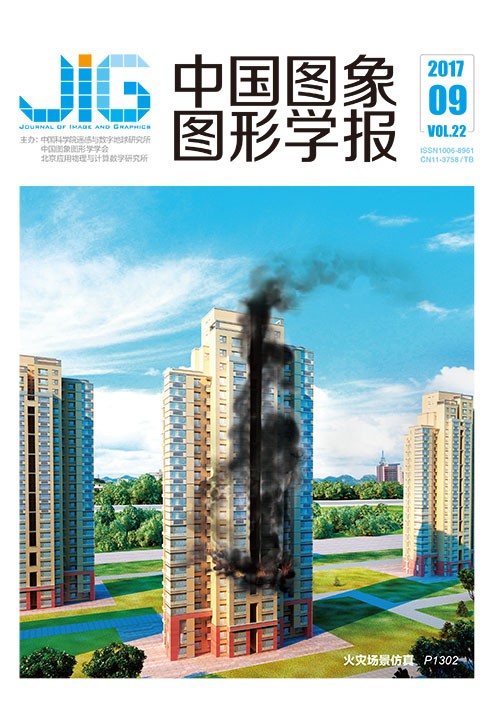
应用雾天退化模型的低照度图像增强
摘 要
目的 针对目前低照度图像增强算法存在噪声敏感、易饱和等现象,提出了一种基于雾天退化模型的低照度图像间接增强算法。方法 首先将低照度图像反转成为拟雾图;拟雾图与真实雾天图像有所不同,一是通常具有大面积明亮区域,二是大气光值较高。对于大面积明亮区域,暗原色先验理论并不适用,不容易精确估计相应透射率,因此,提出利用卷积神经网络求解透射率的方法;又针对全局大气光值易出现饱和现象,提出使用局部大气光值代替全局大气光值,从而得到大气光图;之后,利用导向滤波对透射率图和大气光图进行修正;最后基于大气散射模型还原出无雾图像,再次反转无雾图像得到低照度图像的增强结果。结果 设计了3组实验,第1组实验为各算法的主观对照,第2组实验从客观指标上对各算法进行比较分析,第3组为实验透射率与大气光值的组合对照实验。结果表明,无论是与Retinex和MSRCR(multi-scale retinex with color restoration)为代表的直接增强算法比较,还是与基于He算法的间接增强等算法相比,本文算法在平均梯度、信息熵、峰值信噪比上均表现良好,且本文算法峰值信噪比平均比次优结果高了2.6 dB,相对应的方差较小,可以有效提高视觉效果,不仅有效提升了低照度图像的亮度,又避免了明显的颜色失真、曝光过度等现象。结论 通过定性及定量的实验结果表明,本文算法不仅提高了视觉效果,且场景适应能力较强,能很好地增强室内和室外的低照度图像,且本文算法运行时间中等,若结合cuda技术,还可用于监控视频的实时增强。
关键词
Low-illumination image enhancement method based on a fog-degraded model
Yu Chunyan, Xu Xiaodan, Lin Huixiang, Ye Xinyan(College of Mathematics and Computer Science, Fuzhou University, Fuzhou 430074, China) Abstract
Objective Visual acquisition is a necessary condition in image processing.However,under the low-illumination conditions of nighttime,images obtained using a visual system lose a considerable number of effective features,and thus,always appear to have low contrast and brightness.This scenario will negatively affect the subsequent processing of computer vision applications,such as intelligent surveillance,object detection,and pedestrian tracking.Image enhancement is generally regarded as an effective method for improving visual effects.This method augments valid information by increasing the difference among features and enhancing regions of interest.Existing image enhancement methods include direct and indirect enhancement algorithms.The concept of indirect enhancement algorithms originated from Dong,who found that a low-light image would be similar to a fog image after inversion.Accordingly,low-illumination image enhancement optimization can be extended to fog image restoration.Fog removal algorithms have been introduced to execute an enhancement-like process.However,several enhancement algorithms for low-illumination images are sensitive to noise and easily saturated.This study proposes a low-illumination indirect image enhancement algorithm to improve image quality and avoid the aforementioned imperfections.Method Retinex theory is based on color constancy.An image is segmented into two parts in the division operation.One part is an entrance map,whereas the other is a reflection map.Subsequently,the original reflection component is obtained by reducing,or even eliminating,the impact of the entrance map on the reflected map.Multi-scale retinex with color restoration (MSRCR) is an optimized solution for the color distortion caused by retinex.This solution is based on multi-scale retinex.The introduction of the color recovery factor is a key point,which adjusts the proportional relationship of each RGB component from the original image.However,the He-based method is introduced.The atmospheric scattering model is a fundamental structure of the He-based method.Fog-relevant statistics,namely,dark-channel prior,is obtained by observing fog images.Atmospheric light is acquired according to the obtained information.Coarse transmissivity is estimated by using a minimum filter,and the soft matting interpolation method is applied for optimization.Similar to the He-based method,our method is based on a fog-degraded model.First,our method inverses a low-illumination image and then it generates a pseudo-fog image.The characteristics of the pseudo-fog image differ from those of a foggy image.The pseudo-fog image is mainly characterized by a large occupied bright area and a high atmospheric light value.The classic dark channel theory on fog images is inapplicable to large occupied bright regions and will lead to imprecise transmission map estimation.Second,our method trains a specific convolutional neural network (CNN) to directly predict optical transmissivity for the input image.Synthetic pseudo-fog patches are selected as input,pseudo-fog features are acquired via the progressive convolutional operations of each layer,and Brelu activation function outputs a corresponding transmission parameter ranging from 0 to 1.Third,our method obtains an atmospheric light map replaced with a local atmospheric light value to address the oversaturation caused by global atmospheric light.Guided filtering is adopted to refine the optical transmissivity map and atmospheric light map.The gray scale of the pseudo-fog image is used as a guide image to optimize the transmission map obtained by CNN and the atmospheric light map.The final enhanced image is a reverse result of a fog-removed image,which is restored based on the atmospheric scattering model.Result This study designs three sets of controlled experiments,which are performed on classical image enhancement algorithms,namely,retinex,MSRCR,and indirect enhancement algorithms,including the He-based algorithm.The first set of experiment is conducted from the perspective of subjective visual effects.Accordingly,the second set is evaluated from objective experiments under several evaluation indices,including average gradient,information entropy,and peak signal-to-noise ratio (PSNR).The last experiment is proposed to verify the effectiveness of the parameters (i.e.,transmissivity and atmospheric light) obtained using the proposed method.The result of the subjective and objective aspects shows that retinex is sensitive to noise and causes color distortion,MSRCR tends to cause overexposure due to an excessive increase in mean value,the He-based algorithm according to dark channel prior theory is liable to produce saturation because of its inapplicability to pseudo-fog images,and our method effectively improves visual effects.Our method does not only effectively improve the brightness of low-illumination images,but also avoid evident color distortion and overexposure of restored images.The performance on the PSNR index indicates that compared with a sub-optimal method,our algorithm increases by an average of 2.6.Conclusion The CNN is a widely used feature extraction method.We adopt this method to learn pseudo-fog features via large-scale training of synthetic data,replace the global atmospheric light map with a local one to avoid saturation,and perform guided filtering to refine this map.The results of the qualitative and quantitative experiments show that the proposed algorithm can improve the visual effects and strong adaptability of a scene and can enhance indoor and outdoor low-light images.If combined with CUDA technology,then tour method can be used for the real-time enhancement of videos.
Keywords
low illumination image enhancement atmospheric scattering model convolutional neural network transmission map atmospheric light map
|



 中国图象图形学报 │ 京ICP备05080539号-4 │ 本系统由
中国图象图形学报 │ 京ICP备05080539号-4 │ 本系统由